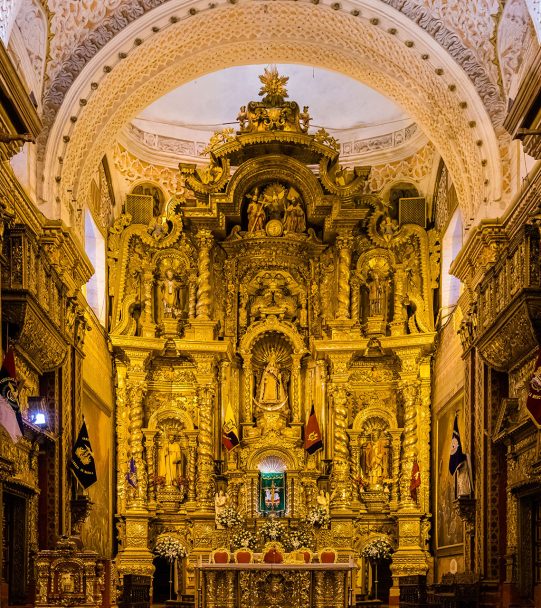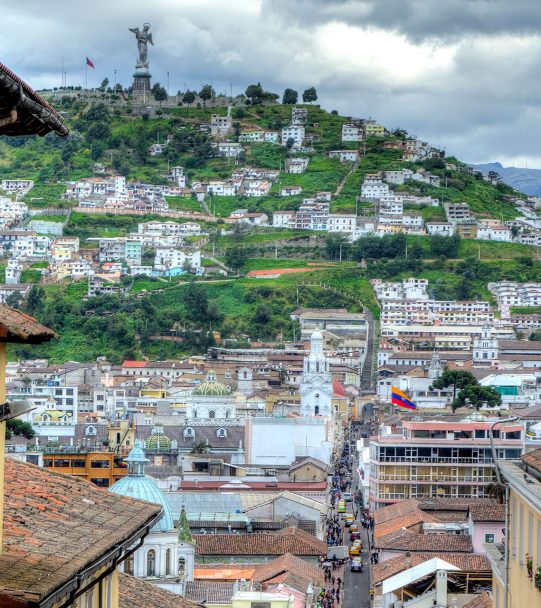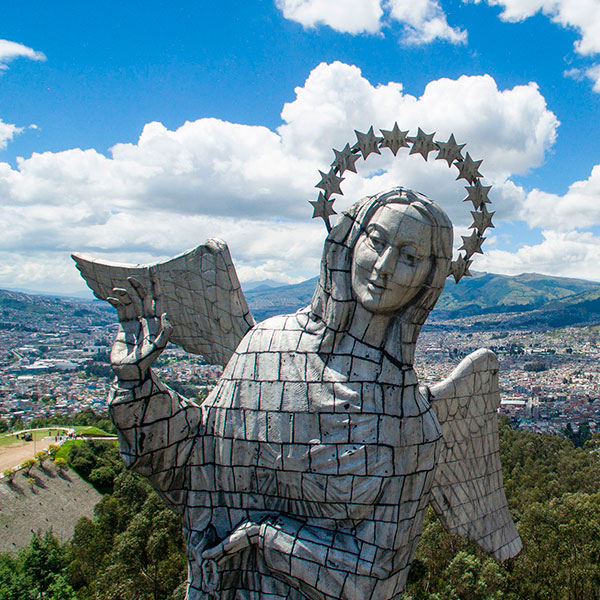Pichincha
Pichincha, in the Andean region of the Ecuador, welcomes you with history, nature and modernity in a single destination. In its capital, Quito, declared Cultural Heritage of Humanity by UNESCO, you can visit a unique historic center, colonial churches and lively squares. A few kilometers away, live the experience of being in the Middle of the World. Enjoy moorland landscapes, imposing volcanoes and cloud forests ideal for hiking and bird watching. Pichincha combines tradition, culture, nature and adventure in every visit.
Connectivity
You can reach Pichincha by road by private vehicle or bus through routes that connect Quito, its capital city, with major cities like Guayaquil y Watershed, The trip takes approximately 8 hours. For those who prefer to fly, the Mariscal Sucre International Airport in the city of Quito is the main gateway to the country. Ecuador The airport has national and international connections that facilitate access from different parts of the world.
Pichincha
Subscribe to receive news about Caminos Andinos
Temperature
Ranges from 4° to 28°.
Weather
Varies according to altitude: cold temperate to warm dry and humid.
More destinations
Activities and attractions
Pichincha invites you to explore a province where history, culture and nature surprise you at every step. Admire the Historic Center of Quito, a World Heritage Site, with colonial churches such as the Compañía de Jesús and the Basílica del Voto Nacional, museums such as the National Museum and the Casa del Alabado, and take a walk in La Ronda. Ride the cable car and see the city from the Rucu Pichincha, or visit the Ciudad Mitad del Mundo and experience being in two hemispheres at once. Discover archaeological sites such as Cochasquí and natural reserves such as Chocó Andino, Pululahua, Pasochoa, Cayambe Coca, Cotopaxi, Illiniza or Antisana. Meet living Kichwa communities, celebrate the Inti Raymi and savor dishes such as yahuarlocro and fritada. Pichincha is memory, altitude and living culture.
Jesuit Church
PHOTO: Ministry of Tourism of Ecuador
Middle of the World City
PHOTO: Ministry of Tourism of Ecuador
Cayambe Coca Park
PHOTO: Ministry of Tourism of Ecuador
Potato Locro
PHOTO: Ministry of Tourism of Ecuador
Fritada
PHOTO: Ministry of Tourism of Ecuador
Discover what we do
-
-
CULTURE
Quito: Andean city with colonial heritage
Quito's Historic Center captivates with its recognition as one of the world's most important UNESCO World Cultural Heritage, where each cobblestone street narrates centuries of history. Tour the imposing baroque-style Church of the Society of Jesus, with its interior covered in gold leaf, and the neo-Gothic Basilica of the National Vow, whose towers offer unforgettable views of the city, among many other churches and convents. Immerse yourself in the cultural richness of the National Museum of Ecuador and the Museum of Pre-Columbian Art Casa del Alabado. Stroll along La Ronda, a charming and colorful cobblestone passage that maintains the tradition of colonial Quito, which will allow you to enjoy its galleries, workshops and cozy cafes.
Middle of the World City
The Ciudad Mitad del Mundo invites you to live the fascination of stepping on the equatorial line marked by the famous monument and experience the unique sensation of being in two hemispheres at the same time. Explore the Intiñán Museum, where interactive replicas and scientific demonstrations reveal secrets of balance and gravity. Tour the Planetarium, admire ethnographic exhibits on Andean culture and enjoy regional handicraft markets. A must-see in Pichincha.
Viewpoint by cable car
The Quito Cable Car takes you on an unforgettable journey to an altitude of over 4,000 meters in just minutes. From the top of the Rucu Pichincha, enjoy panoramic views of the city and Andean volcanoes. Ideal for hiking, photography and contact with the Andean moor, it also has the Vulqano Park amusement park, with rides and family activities. It is one of the best places to admire Quito from the heights and spend a day full of adventure.
Cochasqui: Great pre-Hispanic civilizations
Discover the fascinating legacy of Cochasquí, an archaeological jewel of pre-Hispanic civilization in Ecuador. Located near the city of Quito, this archaeological complex houses 15 truncated pyramids and ceremonial mounds built by the Quitu-Cara. Walk its trails surrounded by nature, visit its site museum and learn about ancestral astronomy, architecture and indigenous rituals. Cochasquí is an ideal place to connect history, landscape and living culture in an environment full of mystery and memory.
-
-
NATURE
Cayambe Volcano: Mountains, snow-capped mountains and volcanoes
The Cayambe volcano, the third highest snow-capped mountain in Ecuador, offers breathtaking landscapes and the unique experience of being on the only glacier crossed by the equator. On its slopes, the Cayambe-Coca National Park awaits you with moorlands, lagoons, waterfalls and an amazing biodiversity. Ideal for hiking, photography and wildlife observation, this park protects species such as spectacled bears and condors. A visit to Cayambe is adventure, nature pure Andean and connection with the mountain.
Andean Chocó Route: Exploration and birdwatching trails
The Andean Chocó of Pichincha invites you to discover one of the most biodiverse regions of Ecuador, declared a Biosphere Reserve by UNESCO. Just an hour from Quito, this green paradise encompasses 286,000 hectares of cloud forests, crystalline rivers and impressive wildlife. Observe more than 600 species of birds, such as the Andean toucan or the Andean cock-of-the-rock, Morpho butterflies and exotic orchids. Visit communities such as Mindo, Calacalí, Nono, Nanegal, Nanegalito, Gualea, Pacto and Yunguilla, where sustainable tourism is experienced with nature, culture and local warmth.
Condor Route: Antisana Ecological Reserve
The Condor Route, in the Antisana Ecological Reserve, offers you a unique experience in one of the most breathtaking landscapes of the Andes. This tour takes you through moorlands, lagoons and natural viewpoints where you can observe the majestic Andean condor in its habitat. The Mica Lagoon, surrounded by mountains and native vegetation, is ideal for hiking and wildlife viewing. With clear skies, the imposing Antisana volcano completes a perfect postcard of pure nature and fresh air.
Inhabited Crater: Pululahua Geobotanical Reserve
The Pululahua Geobotanical Reserve surprises you with one of the few inhabited volcanic craters in the world, located a few kilometers from Quito. From its natural viewpoints, admire the immensity of its caldera surrounded by domes and cloudy vegetation. Walk along trails ideal for hiking, biking or horseback riding, among orchids, birds and unique landscapes. Visit ancient colonial structures and agricultural communities that maintain traditional knowledge. Pululahua is nature, living geology and rural culture in a silent and breathtaking environment.
-
-
ANCESTRAL COMMUNITIES AND RURALITY
The Kitu Kara, Kayambi and Yumbos peoples, belonging to the Kichwa nationality of Ecuador, invite you to discover a living millenary legacy. The Yumbos, ancient inhabitants of the jungle since 800 A.D., left amazing traces such as ceremonial mounds, terraces, petroglyphs and sacred pools. Today, you can explore more than 660 tolas and a network of ancestral of roads in Yunguilla, Calacalí, Alaspungo and in Nanegalito the Tulipe Complex.
Fairs and festivals of ancestral origin:
Pichincha invites you to experience its ancestral festivities, full of spirituality, color and tradition. In June, participate in the Inti Raymi, where communities pay homage to the sun and celebrate the new agricultural cycle with dances, offerings and Andean rituals. In February or March, enjoy the Pawkar Raymi, the blossoming festival, with music, chicha and traditional dress. In September, the Killa Raymi honors the moon, women and fertility with ceremonies and lively cultural expressions.
Holidays:
Pichincha celebrates with intensity some of its unmissable festivities that show its cultural and spiritual soul. The Inti Raymi, celebrated since June 21 in the Inter-Andean Alley, has its most outstanding expression in Cayambe, where it merges with the traditional Festivities of San Pedro del Sol, becoming one of the main cultural attractions of the province. In Quito in April, Holy Week fills the Historic Center with solemn processions such as that of Jesus del Gran Poder, an icon of faith and tradition. In November, in El Quinche, thousands of faithful walk to the sanctuary during the Feast of the Virgin of El Quinche, a mixture of devotion and popular celebration. And in December, the Fiestas de Quito light up the city with parades, music, chivas, traditional games and joy in every corner.
-
-
GASTRONOMY
Traditional Andean cuisine
The traditional cuisine of Pichincha invites you to discover intense and authentic flavors. Savor hornado, slow-baked pork, served with mote, llapingacho or potato tortilla with salad. Try yahuarlocro, a thick potato soup with lamb offal, cooked blood, onion and avocado. Enjoy the fritada, pork cooked in its fat accompanied by mote, potatoes and ripe plantain. The locro de papa, a creamy soup made with potatoes, cheese and achiote. The crunchy empanadas de viento are filled with cheese and sprinkled with sugar. And don't miss the mishqui tripe, roasted and served with mote and hot bell pepper. For dessert you can try the famous candied sons with panela and fresh cheese, undoubtedly a delicacy for the palate.
-
-
CRAFTS
The handicrafts of Pichincha reflect the creativity and living heritage of its people. From the colorful wool weavings in Cayambe to the delicate masapan figures made in Calderon, each piece tells a story of identity and tradition. In Quito, you will find artistic ceramics, embossed leather and silver jewelry, ideal for an authentic souvenir. The Mercado Artesanal La Mariscal brings together the best of this cultural expression. Also in rural areas of the Andean Chocó, wooden sculptures and handmade musical instruments are not to be missed.
CULTURE
Quito: Andean city with colonial heritage
Quito's Historic Center captivates with its recognition as one of the world's most important UNESCO World Cultural Heritage, where each cobblestone street narrates centuries of history. Tour the imposing baroque-style Church of the Society of Jesus, with its interior covered in gold leaf, and the neo-Gothic Basilica of the National Vow, whose towers offer unforgettable views of the city, among many other churches and convents. Immerse yourself in the cultural richness of the National Museum of Ecuador and the Museum of Pre-Columbian Art Casa del Alabado. Stroll along La Ronda, a charming and colorful cobblestone passage that maintains the tradition of colonial Quito, which will allow you to enjoy its galleries, workshops and cozy cafes.
Middle of the World City
The Ciudad Mitad del Mundo invites you to live the fascination of stepping on the equatorial line marked by the famous monument and experience the unique sensation of being in two hemispheres at the same time. Explore the Intiñán Museum, where interactive replicas and scientific demonstrations reveal secrets of balance and gravity. Tour the Planetarium, admire ethnographic exhibits on Andean culture and enjoy regional handicraft markets. A must-see in Pichincha.
Viewpoint by cable car
The Quito Cable Car takes you on an unforgettable journey to an altitude of over 4,000 meters in just minutes. From the top of the Rucu Pichincha, enjoy panoramic views of the city and Andean volcanoes. Ideal for hiking, photography and contact with the Andean moor, it also has the Vulqano Park amusement park, with rides and family activities. It is one of the best places to admire Quito from the heights and spend a day full of adventure.
Cochasqui: Great pre-Hispanic civilizations
Discover the fascinating legacy of Cochasquí, an archaeological jewel of pre-Hispanic civilization in Ecuador. Located near the city of Quito, this archaeological complex houses 15 truncated pyramids and ceremonial mounds built by the Quitu-Cara. Walk its trails surrounded by nature, visit its site museum and learn about ancestral astronomy, architecture and indigenous rituals. Cochasquí is an ideal place to connect history, landscape and living culture in an environment full of mystery and memory.
NATURE
Cayambe Volcano: Mountains, snow-capped mountains and volcanoes
The Cayambe volcano, the third highest snow-capped mountain in Ecuador, offers breathtaking landscapes and the unique experience of being on the only glacier crossed by the equator. On its slopes, the Cayambe-Coca National Park awaits you with moorlands, lagoons, waterfalls and an amazing biodiversity. Ideal for hiking, photography and wildlife observation, this park protects species such as spectacled bears and condors. A visit to Cayambe is adventure, nature pure Andean and connection with the mountain.
Andean Chocó Route: Exploration and birdwatching trails
The Andean Chocó of Pichincha invites you to discover one of the most biodiverse regions of Ecuador, declared a Biosphere Reserve by UNESCO. Just an hour from Quito, this green paradise encompasses 286,000 hectares of cloud forests, crystalline rivers and impressive wildlife. Observe more than 600 species of birds, such as the Andean toucan or the Andean cock-of-the-rock, Morpho butterflies and exotic orchids. Visit communities such as Mindo, Calacalí, Nono, Nanegal, Nanegalito, Gualea, Pacto and Yunguilla, where sustainable tourism is experienced with nature, culture and local warmth.
Condor Route: Antisana Ecological Reserve
The Condor Route, in the Antisana Ecological Reserve, offers you a unique experience in one of the most breathtaking landscapes of the Andes. This tour takes you through moorlands, lagoons and natural viewpoints where you can observe the majestic Andean condor in its habitat. The Mica Lagoon, surrounded by mountains and native vegetation, is ideal for hiking and wildlife viewing. With clear skies, the imposing Antisana volcano completes a perfect postcard of pure nature and fresh air.
Inhabited Crater: Pululahua Geobotanical Reserve
The Pululahua Geobotanical Reserve surprises you with one of the few inhabited volcanic craters in the world, located a few kilometers from Quito. From its natural viewpoints, admire the immensity of its caldera surrounded by domes and cloudy vegetation. Walk along trails ideal for hiking, biking or horseback riding, among orchids, birds and unique landscapes. Visit ancient colonial structures and agricultural communities that maintain traditional knowledge. Pululahua is nature, living geology and rural culture in a silent and breathtaking environment.
ANCESTRAL COMMUNITIES AND RURALITY
The Kitu Kara, Kayambi and Yumbos peoples, belonging to the Kichwa nationality of Ecuador, invite you to discover a living millenary legacy. The Yumbos, ancient inhabitants of the jungle since 800 A.D., left amazing traces such as ceremonial mounds, terraces, petroglyphs and sacred pools. Today, you can explore more than 660 tolas and a network of ancestral of roads in Yunguilla, Calacalí, Alaspungo and in Nanegalito the Tulipe Complex.
Fairs and festivals of ancestral origin:
Pichincha invites you to experience its ancestral festivities, full of spirituality, color and tradition. In June, participate in the Inti Raymi, where communities pay homage to the sun and celebrate the new agricultural cycle with dances, offerings and Andean rituals. In February or March, enjoy the Pawkar Raymi, the blossoming festival, with music, chicha and traditional dress. In September, the Killa Raymi honors the moon, women and fertility with ceremonies and lively cultural expressions.
Holidays:
Pichincha celebrates with intensity some of its unmissable festivities that show its cultural and spiritual soul. The Inti Raymi, celebrated since June 21 in the Inter-Andean Alley, has its most outstanding expression in Cayambe, where it merges with the traditional Festivities of San Pedro del Sol, becoming one of the main cultural attractions of the province. In Quito in April, Holy Week fills the Historic Center with solemn processions such as that of Jesus del Gran Poder, an icon of faith and tradition. In November, in El Quinche, thousands of faithful walk to the sanctuary during the Feast of the Virgin of El Quinche, a mixture of devotion and popular celebration. And in December, the Fiestas de Quito light up the city with parades, music, chivas, traditional games and joy in every corner.
GASTRONOMY
Traditional Andean cuisine
The traditional cuisine of Pichincha invites you to discover intense and authentic flavors. Savor hornado, slow-baked pork, served with mote, llapingacho or potato tortilla with salad. Try yahuarlocro, a thick potato soup with lamb offal, cooked blood, onion and avocado. Enjoy the fritada, pork cooked in its fat accompanied by mote, potatoes and ripe plantain. The locro de papa, a creamy soup made with potatoes, cheese and achiote. The crunchy empanadas de viento are filled with cheese and sprinkled with sugar. And don't miss the mishqui tripe, roasted and served with mote and hot bell pepper. For dessert you can try the famous candied sons with panela and fresh cheese, undoubtedly a delicacy for the palate.
CRAFTS
The handicrafts of Pichincha reflect the creativity and living heritage of its people. From the colorful wool weavings in Cayambe to the delicate masapan figures made in Calderon, each piece tells a story of identity and tradition. In Quito, you will find artistic ceramics, embossed leather and silver jewelry, ideal for an authentic souvenir. The Mercado Artesanal La Mariscal brings together the best of this cultural expression. Also in rural areas of the Andean Chocó, wooden sculptures and handmade musical instruments are not to be missed.
 Skip to content
Skip to content















